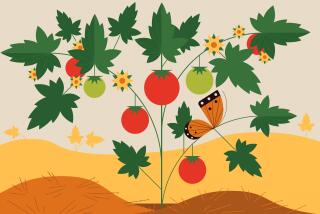Tips for Growing Tomatoes
- Share via
Here are some suggestions from nursery and gardening experts for cultivating healthy tomatoes:
* Tomato plants work hard. Reward them with good soil. Well-decomposed compost is the ideal amendment, but redwood mulch is also good.
* Tomato plants have deep roots; give them room. If planting in the ground isn’t an option, use a large container. A half whiskey barrel is best, but a 15-gallon container will do.
* Tomatoes need lots of sun--a minimum of six hours per day. More is better. Place plants in the sunniest, warmest location in your garden.
* Tomatoes thrive on a consistent watering schedule. Water deeply but not too frequently. Every 10 to 14 days is a common recommendation. If growing in containers, let the top inch of soil dry out between waterings. Avoid overhead watering if possible as it contributes to mildew problems. If that is not possible, water early in the day so foliage will dry before evening.
* Tomato plants are light feeders. Many gardeners rely on slow-release Osmocote added to the soil at the time of transplanting for fertilizing. Others prefer more frequent fertilizing with a balanced formula product, like a 14-14-14 combination. The main thing is not to use a nitrogen-heavy product (the first number in the ratio), which produces foliage at the expense of fruit.
* Tomatoes need a support system. Even compact bush types, bred not to need staking, do better propped up in a short cage, say experienced growers. (Fruit ripens better off the ground, and the improved air circulation benefits the foliage.) Larger varieties that continue to grow until temperatures become too cool for them to set fruit need something more substantial than nursery cages. The Fullerton Arboretum uses cages of seven-foot-wide, welded wire screening (the kind sold for reinforcing concrete). Five feet of wire creates a 1 1/2-foot cylinder. A heavy, wooden stake, at least six feet tall, would also work. A redwood trellis is another, and pretty, option. Trellising also makes fruit very visible so ripe tomatoes are not overlooked. Whatever support you decide on, put it in when you transplant the seedling, no matter how ridiculous it looks towering over the tiny plant.
* Tomatoes attract pests. But there are simple solutions that don’t require pesticides. Insecticidal soaps, for instance, control aphids, and Bacillus thuringiensis-based sprays kill tomato worms. Neither product is toxic to people or animals. Planting flowers that attract beneficial insects also helps keep pests in check. Cosmos, coriander, alyssum, yarrow and sunflowers are examples.






